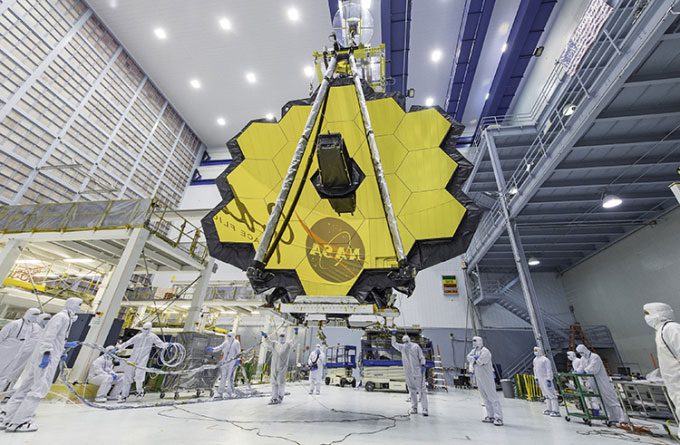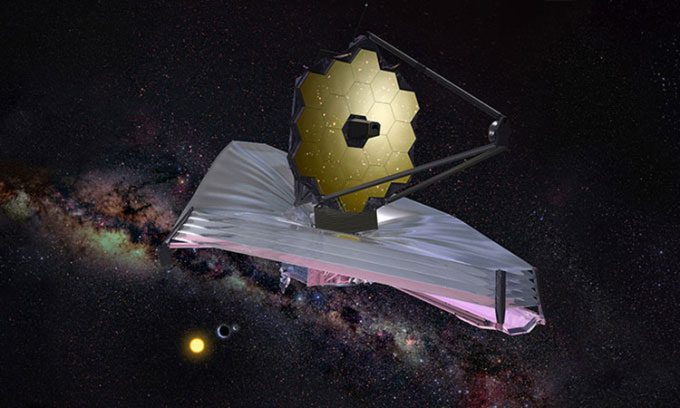Technical challenges and delays are the main reasons why NASA’s James Webb Space Telescope has cost many times more than originally estimated.

James Webb Telescope inside the manufacturing facility. (Photo: NASA)
The James Webb Space Telescope is one of the most expensive scientific projects in history. The initial estimated cost in 2000 was only $1 billion, but the complexity of the telescope surprised NASA. It became so expensive that the U.S. Congress nearly scrapped the project. When the telescope was launched at the end of 2021, the cost had risen to over $10 billion. So why did NASA spend so much money on this project? And why did it take so long? The answer partly lies in the origins of the stars.
On December 25, 2021, James Webb entered orbit. Its destination was a point in deep space known as Lagrange Point 2, located 1 million miles from Earth, further than any astronaut has ever traveled, and this is also the perfect location to study the birth of the universe. Light from the first stars began to spread shortly after the Big Bang, and it cooled down, transitioning from visible light to infrared light over billions of years. That is why James Webb was designed to collect light in the infrared spectrum.
“The James Webb Space Telescope is designed to examine our entire history, from the first objects that formed after the Big Bang to those present right here, in the Solar System that formed alongside Earth,” said John C. Mather, senior scientist of the James Webb project, to Insider.
Webb is very large. Therefore, it needed to be folded to fit on top of the Ariane 5 rocket before launch and then automatically unfold in space. NASA scientists described this journey as “30 days of terror” because everything had to go right with no less than 344 potential points of failure. Just one small flaw could turn the super telescope into space debris.
The mission was successful, but 20 years ago, no one could have imagined it would take so much time and money to get it to the launch pad. Part of the reason is the demand for perfection. “We kept building and testing, building and testing… until we were satisfied,” Mather said.
NASA could not repeat the mistakes made with the Hubble Telescope, Webb’s predecessor. After its launch in 1990, the first images were blurry due to significant spherical aberration.
As a result, astronauts had to repair Hubble’s mirror while it was in space. NASA spent $2 billion on Hubble at that time. The repair cost $86 million. This taught NASA a valuable lesson. Therefore, with Webb, they had to get everything right from the start. This was truly complex. “That’s the part that I think scared all of us the most,” Mather recalled.

Simulation of James Webb operating in space. (Photo: NASA)
In 2000, the budget was $1 billion, but by 2005, the budget quadrupled to $4.5 billion. By 2010, the year it was supposed to launch, no equipment or primary mirror had been delivered to NASA. The estimated budget in 2010 had risen to $6.5 billion.
“By 2011, there were many issues related to oversight, communication, leadership, management, cost estimation, excessive optimization, almost everything you could think of happening,” said Cristina Chaplain, former director of the U.S. Government Accountability Office.
Members of Congress even considered scrapping the project. Some argued that we should cut our losses and move on. In 2011, Congress decided to cap the budget at $8 billion and required Cristina Chaplain to review the project annually. But nothing could really stop costs from rising, as nearly every component of the telescope was newly invented during development.
Especially towards the end of the project, many team members thought that contractor labor could be reduced and they had money to pay for other things, but labor costs remained high due to too many technical issues to resolve.
Although often compared to Hubble, James Webb has a mirror that is six times larger than its predecessor, requiring much more advanced technology and specialized conditions to operate.
“Those two things combined create a really tough problem, and honestly, some of us thought it was too crazy from the start,” said Paul Geithner, deputy project manager, in an interview.
The James Webb Telescope requires extremely cold conditions for its infrared cameras to operate. Specifically, -388 degrees F (-233 degrees C). To protect these sensitive instruments from the heat of the Sun, NASA created a five-layer sunshield the size of a tennis court. Think of the most advanced and complex beach umbrella you can imagine. It can withstand extreme temperature changes and even small meteoroids.
“The temperature at which we operate Webb’s cold side far exceeds anyone’s normal daily experience, and materials become really strange at those temperatures. That’s a technical challenge,” Geithner added.
But even that is not cold enough for one of Webb’s cameras. This camera requires something called a cooler to lower the temperature to -447 degrees F (-266 degrees C). NASA spent over a decade and $150 million developing the cooler, which was initially expected to cost only $22 million.
In 2018, the U.S. Congress had to raise the spending cap set in 2011. By the time it was ready for launch in 2021, the telescope had cost $8.8 billion, making it one of the most expensive scientific projects in history.
But there was still one more challenge: transporting it from California to a European spaceport in French Guiana in South America. Details had to be kept secret as the valuable cargo would be a tempting target for pirates. It took 16 days to travel from California through the Panama Canal to the launch site. The European Space Agency (ESA) funded and oversaw the launch, as well as manufactured two of Webb’s instruments. Together, the European and Canadian space agencies contributed an additional $1 billion beyond NASA’s $8.8 billion, bringing the total close to $10 billion.
NASA designed this telescope to operate for 10 years, but the leftover fuel from the launch could potentially double its lifespan. NASA will spend over $850 million to operate Webb over the next five years. The extended lifespan it could achieve will of course require more funding.
So far, Webb has very little to show for itself aside from this selfie through its large mirror. However, the images it will capture from the cameras facing outward in mid-2022 are what everyone is waiting for. Scientists hope that providing a glimpse into the birth of the universe will make all the time and costs worthwhile.
Hubble’s observations have led to 19,000 scientific papers. Many of these papers have changed our understanding of the universe, and just one of them revealed the discovery of water on Jupiter’s smallest moon, known as Europa. James Webb will have several significant targets to observe. “And that’s the truly powerful value of these telescopes – Webb and Hubble – allowing us to continue making incredible scientific discoveries year after year,” emphasized planetary astronomer Heidi Hammel, a member of the James Webb project.





















































